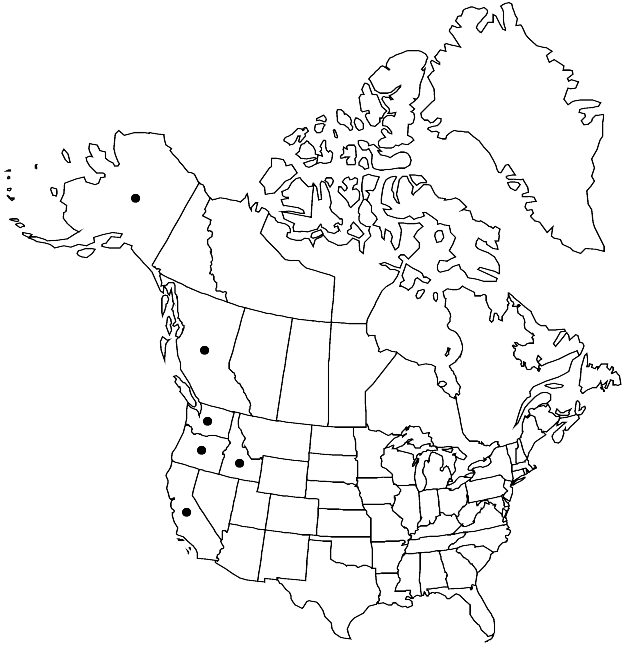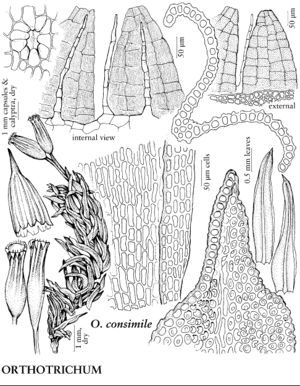Difference between revisions of "Orthotrichum consimile"
J. Linn. Soc., Bot. 8: 24. 1864.
FNA>Volume Importer |
FNA>Volume Importer |
||
| Line 15: | Line 15: | ||
|name=Orthotrichum columbicum | |name=Orthotrichum columbicum | ||
|authority=Mitten | |authority=Mitten | ||
| − | }}{{Treatment/ID/Synonym | + | }} {{Treatment/ID/Synonym |
|name=O. hendersonii | |name=O. hendersonii | ||
|authority=Renault & Cardot | |authority=Renault & Cardot | ||
| − | }}{{Treatment/ID/Synonym | + | }} {{Treatment/ID/Synonym |
|name=O. pulchellum var. columbicum | |name=O. pulchellum var. columbicum | ||
|authority=(Mitten) Grout | |authority=(Mitten) Grout | ||
| − | }}{{Treatment/ID/Synonym | + | }} {{Treatment/ID/Synonym |
|name=O. pulchellum var. leucodon | |name=O. pulchellum var. leucodon | ||
|authority=Venturi | |authority=Venturi | ||
| − | }}{{Treatment/ID/Synonym | + | }} {{Treatment/ID/Synonym |
|name=O. pulchellum var. longipes | |name=O. pulchellum var. longipes | ||
|authority=Lesquereux & James | |authority=Lesquereux & James | ||
| − | }}{{Treatment/ID/Synonym | + | }} {{Treatment/ID/Synonym |
|name=O. pulchellum var. productipes | |name=O. pulchellum var. productipes | ||
|authority=Renault & Cardot | |authority=Renault & Cardot | ||
| − | }}{{Treatment/ID/Synonym | + | }} {{Treatment/ID/Synonym |
|name=O. pulchellum subsp. ulotiforme | |name=O. pulchellum subsp. ulotiforme | ||
|authority=(Renault & Cardot) Kindberg | |authority=(Renault & Cardot) Kindberg | ||
| − | }}{{Treatment/ID/Synonym | + | }} {{Treatment/ID/Synonym |
|name=O. ulotiforme | |name=O. ulotiforme | ||
|authority=unknown | |authority=unknown | ||
| Line 50: | Line 50: | ||
|elevation=low to moderate elevations | |elevation=low to moderate elevations | ||
|distribution=B.C.;Alaska;Calif.;Idaho;Oreg.;Wash.;Europe. | |distribution=B.C.;Alaska;Calif.;Idaho;Oreg.;Wash.;Europe. | ||
| − | |discussion=<p>Orthotrichum consimile is distinguished from superficially similar species of Ulota by its glabrous calyptrae, immersed stomata, and undifferentiated basal laminal cells. From O. pulchellum, it differs by having stomata confined to the proximal portion of the capsule and an exostome of eight yellowish teeth that are finely papillose on the outer surface and finely striate on the inner. Also, O. consimile is much larger and has capsules that are long-exserted and constricted below the mouth when old and dry. The stomata are partially covered by subsidiary cells.</p> | + | |discussion=<p><i>Orthotrichum consimile</i> is distinguished from superficially similar species of <i>Ulota</i> by its glabrous calyptrae, immersed stomata, and undifferentiated basal laminal cells. From <i>O. pulchellum</i>, it differs by having stomata confined to the proximal portion of the capsule and an exostome of eight yellowish teeth that are finely papillose on the outer surface and finely striate on the inner. Also, <i>O. consimile</i> is much larger and has capsules that are long-exserted and constricted below the mouth when old and dry. The stomata are partially covered by subsidiary cells.</p> |
|tables= | |tables= | ||
|references= | |references= | ||
| Line 73: | Line 73: | ||
|publication year=1864 | |publication year=1864 | ||
|special status=Selected by author to be illustrated | |special status=Selected by author to be illustrated | ||
| − | |source xml=https://jpend@bitbucket.org/aafc-mbb/fna-data-curation.git/src/ | + | |source xml=https://jpend@bitbucket.org/aafc-mbb/fna-data-curation.git/src/8f726806613d60c220dc4493de13607dd3150896/coarse_grained_fna_xml/V28/V28_63.xml |
|genus=Orthotrichum | |genus=Orthotrichum | ||
|species=Orthotrichum consimile | |species=Orthotrichum consimile | ||
Revision as of 17:07, 18 September 2019
Plants 8–20 cm. Stem leaves erect, crisped-flexuose when dry, linear-lanceolate, 2–3.2 mm; margins recurved to near apex, sometimes reflexed beyond, entire; apex acuminate (sometimes bluntly so) or acute; basal laminal cells linear-elongate to long-rectangular, walls thick, not nodose; distal cells 7–11 µm, 1-stratose, smooth or papillae 1 or 2 per cell, blunt, low. Specialized asexual reproduction absent. Sexual condition gonioautoicous. Seta (1.5–)2.5–6 mm. Capsule exserted to long-exserted, ovate-oblong when young, elliptic-cylindric when old, 2.5–6 mm, 8-ribbed entire length; stomata immersed, in neck to mid capsule; peristome double; prostome absent; exostome teeth 8, erect when mature, reflexed when old, external surface very finely and densely papillose, internal surface finely striate; endostome segments usually 16, rarely 8 (sometimes 8 long, 8 short), not well developed, of 1 row of cells, smooth or finely roughened. Calyptra oblong-conic to short-conic, smooth, naked or rarely sparsely hairy, hairs not papillose. Spores 12–14 µm.
Habitat: Tree trunks, branches in coniferous forests, boulders in shaded habitats
Elevation: low to moderate elevations
Distribution

B.C., Alaska, Calif., Idaho, Oreg., Wash., Europe.
Discussion
Orthotrichum consimile is distinguished from superficially similar species of Ulota by its glabrous calyptrae, immersed stomata, and undifferentiated basal laminal cells. From O. pulchellum, it differs by having stomata confined to the proximal portion of the capsule and an exostome of eight yellowish teeth that are finely papillose on the outer surface and finely striate on the inner. Also, O. consimile is much larger and has capsules that are long-exserted and constricted below the mouth when old and dry. The stomata are partially covered by subsidiary cells.
Selected References
None.
